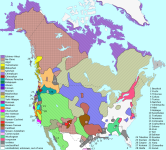- Reaction score
- 7,346
- Points
- 1,160
All this started with Chrystia Freeland telling the Spud Islanders she didn't need a car and reading Tasha Kheiriddin's take in the National Post.

 nationalpost.com
nationalpost.com
Ignore the MPs for a bit. I'll be back to them.
4% of Canada's population enjoy Chrystia Freeland's campus lifestyle, living within cycling distance of a subway and a college campus.
The rest of Canada uses cars.
The sweet spot appears to be about 20 to 30 minutes from downtown. 66% of the population lives a commuting life spending an hour in the car each day.
Now, I would argue that if the 66% wanted to live like Chrystia's 4% they would have moved a while ago and the suburbs would be imploding and not spreading.
Off hand I would suggest that the Car Party has it.
By the way a real city, like Singapore, with a population of 5,637,000 has a density of 7804 people per km2. London is comparable. New York has about double the density. No matter how far Greater Toronto, Montreal and Vancouver expand they are never going to achieve the same tax base that those cities have. The more they expand the less dense they become and the more it costs to build the infrastructure they crave. They should just quit and work within their means. Maybe once they have perfected their urban utopias they will attract more people from the suburbs.
....
Reviewing the above data found me considering the native situation which brought me around to the number of MPs
From Stats Canada - Self-Identified - 5% of the Population
Looking at that number in context of Canada at large.
So the settler population, 93 to 95% of the total population occupies 22% of the land at an average density of 0.1 km2/person or 10 people per km2
The native population, 3-5% of the total population occupies 78% of the land at an average density of 6 km2/person.
The native land and density stats are drawn from the 17 largest ridings in Canada.
Do I have a point?
The native population occupying 78% of the land is roughly the same as Chrystia Freeland's urban population occupying 0.003% of the land.
And in between we have 90% of the population living on 20% of the land.
And Chrystia Freeland's buddies are making the rules for the rest of us...

Tasha Kheiriddin: The carbon tax is coming back to bite the Liberals, hard
Only 32 per cent of Canadians think the carbon tax is effective at reducing fuel consumption — and they're right
| People | Area (km2) | km2/person | MPs |
| 40,000,000 | 9,985,000 | 0.2 | 338 |
Ignore the MPs for a bit. I'll be back to them.
| Census Metropolitan Areas | Population | % of Population | Area (km2) | % of Area | Density (People/km2) |
| Primary Downtowns | 1,281,474 | ||||
| Secondary Downtowns | 351,930 | ||||
| Downtowns | 1,633,404 | 4% | 303 | 0.003% | 5385 |
| Urban Fringes - 10 min | 6,484,325 | 16% | 3,707 | 0.037% | 1749 |
| Near Suburb - 20 min | 9,024,144 | 23% | 17,091 | 0.171% | 528 |
| Intermediate Suburb - 30 min | 5,055,023 | 13% | 22,873 | 0.229% | 221 |
| Distant Suburb - >30 min | 5,436,153 | 14% | 76,566 | 0.767% | 71 |
| Urban Totals | 27,633,049 | 69% | 120,541 | 1.2% | 229 |
4% of Canada's population enjoy Chrystia Freeland's campus lifestyle, living within cycling distance of a subway and a college campus.
The rest of Canada uses cars.
The sweet spot appears to be about 20 to 30 minutes from downtown. 66% of the population lives a commuting life spending an hour in the car each day.
Now, I would argue that if the 66% wanted to live like Chrystia's 4% they would have moved a while ago and the suburbs would be imploding and not spreading.
Off hand I would suggest that the Car Party has it.
By the way a real city, like Singapore, with a population of 5,637,000 has a density of 7804 people per km2. London is comparable. New York has about double the density. No matter how far Greater Toronto, Montreal and Vancouver expand they are never going to achieve the same tax base that those cities have. The more they expand the less dense they become and the more it costs to build the infrastructure they crave. They should just quit and work within their means. Maybe once they have perfected their urban utopias they will attract more people from the suburbs.
....
Reviewing the above data found me considering the native situation which brought me around to the number of MPs
From Stats Canada - Self-Identified - 5% of the Population
| Indigenous |
| 1,807,250 |
| 5% |
Looking at that number in context of Canada at large.
| People | Area (km2) | km2/person | MPs | |
| Total | 40,000,000 | 9,985,000 | 0.2 | 338 |
| Native | 1,306,382 | 7,790,605 | 6.0 | 17 |
| 3% | 78% | 5% | ||
| Settler | 38,693,618 | 2,194,395 | 0.1 | 321 |
| 97% | 22% | 95% |
So the settler population, 93 to 95% of the total population occupies 22% of the land at an average density of 0.1 km2/person or 10 people per km2
The native population, 3-5% of the total population occupies 78% of the land at an average density of 6 km2/person.
The native land and density stats are drawn from the 17 largest ridings in Canada.
| People | Area (km2) | km2/person | |
| Nunavut | 31,906 | 2,093,190 | 65.6 |
| Labrador | 26,728 | 294,330 | 11.0 |
| Abitibi - James Bay | 85,475 | 854,754 | 10.0 |
| NWT | 41,462 | 1,346,106 | 32.5 |
| Desnethe Churchill | 69,471 | 342,903 | 4.9 |
| Churchill | 85,148 | 494,701 | 5.8 |
| Kenora | 55,977 | 321,741 | 5.7 |
| Timmins | 83,104 | 251,599 | 3.0 |
| Algoma | 79,801 | 100,103 | 1.3 |
| Abitibi - Temiscaming | 102,794 | 37,429 | 0.4 |
| Manicouagan | 94,766 | 264,226 | 2.8 |
| Yukon | 33,897 | 482,443 | 14.2 |
| Skeena | 90,586 | 327,275 | 3.6 |
| Cariboo | 108,252 | 83,193 | 0.8 |
| Peace River | 107,382 | 243,276 | 2.3 |
| Peace River | 108,095 | 105,924 | 1.0 |
| Fort McMurray | 101,538 | 147,412 | 1.5 |
Do I have a point?
The native population occupying 78% of the land is roughly the same as Chrystia Freeland's urban population occupying 0.003% of the land.
And in between we have 90% of the population living on 20% of the land.
And Chrystia Freeland's buddies are making the rules for the rest of us...
Last edited:








